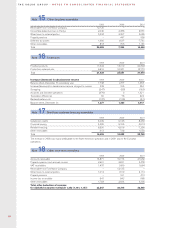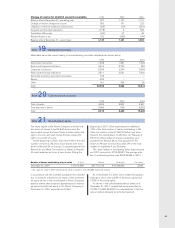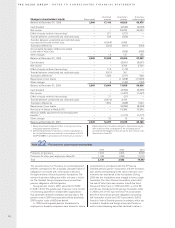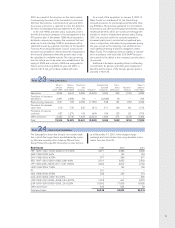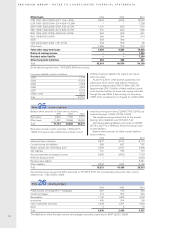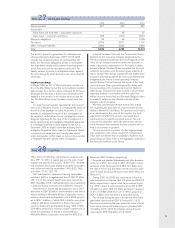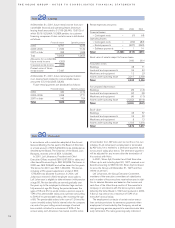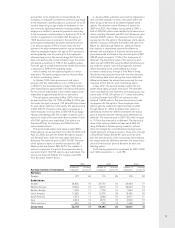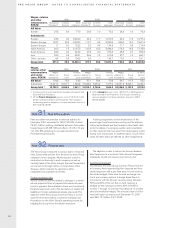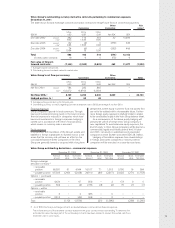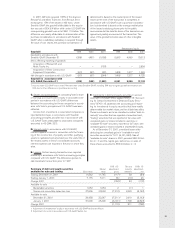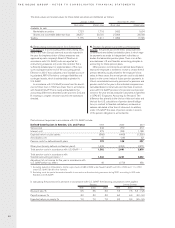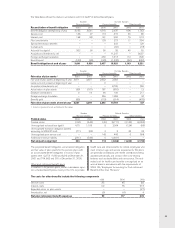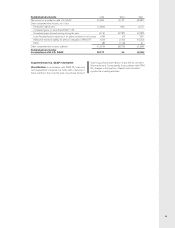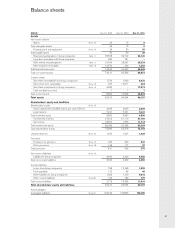Volvo 2001 Annual Report Download - page 82
Download and view the complete annual report
Please find page 82 of the 2001 Volvo annual report below. You can navigate through the pages in the report by either clicking on the pages listed below, or by using the keyword search tool below to find specific information within the annual report.
THE VOLVO GROUP · NOTES TO CONSOLIDATED FINANCIAL STATEMENTS
78
Credit risks in financial instruments
Credit risk in financial investments
The liquidity in the Group is invested mainly in local cash
pools or directly with Volvo Treasury. This concentrates
the credit risk within the Group’s in-house bank. Volvo
Treasury invests the liquid funds in the money and capital
markets.
All investments must meet criteria for low credit risk
and high liquidity. In accordance with Volvo’s credit policy,
counterparties for both investments and transactions in
derivatives must have received a rating of “A” or better
from one of the well-established credit-rating institutions.
Counterparty risks
The derivative instruments used by Volvo to reduce its
foreign-exchange and interest-rate risk in turn give rise
to a counterparty risk, the risk that a counterparty will not
fulfill its part of a forward or option contract, and that a
potential gain will not be realized. Transactions with
derivative instruments are mainly conducted via Volvo
Treasury which means that the counterparty risk is con-
centrated within the Group’s in-house bank. Where
appropriate, the Volvo Group arranges master netting
agreements with the counterparty to reduce exposure.
The credit exposure in interest-rate and foreign exchange
contracts is represented by the positive fair value – the
potential gain on these contracts – as of the reporting
date. The risk exposure is calculated daily. The credit risk
in futures contracts is limited through daily or monthly
cash settlements of the net change in value of open
contracts. The estimated exposure in foreign exchange
contracts, interest-rate swaps and futures, and options
amounted to 654, 4,669 and 0 as of December 31,
2001.
Volvo Group outstanding derivatives – financial exposure
December 31, 1999 December 31, 2000 December 31, 2001
Notional Book Estimated Notional Book Estimated Notional Book Estimated
amount value fair value amount value fair value amount value fair value
Interest-rate swaps 6
– receivable
position 87,647 486 3,055 64,345 561 2,990 62,456 3,670 4,549
– payable position 94,934 (373) (3,461) 57,488 (366) (2,969) 86,328 (3,888) (4,633)
Forwards and futures
– receivable
position 231,907 – 99 174,576 0 201 230,323 120 120
– payable position 220,640 – (61) 201,657 (28) (247) 250,390 (126) (126)
Foreign exchange
derivative contracts 5
– receivable
position – – – 32,741 34 1,046 6,306 96 100
– payable position – – – 21,668 (76) (2,894) 21,465 (428) (435)
Options purchased,
caps and floors
– receivable
position – – – 52 0 1 – – –
– payable position – – – – – – – – –
Options written,
caps and floors
– receivable
position – – – – – – – – –
– payable position – – – 55 0 0 – – –
Total 113 (368) 125 (1,873) (556) (425)
6As from 2000 interest-rate swaps in foreign currencies are reported as financial exposure contracts and are included in interest-rate
swaps. Comparative figures for 1999 have been calculated.
Interest-rate risks
Interest-rate risks relate to the risk that changes in inter-
est-rate levels affect the Group’s profit. By matching
fixed-interest periods of financial assets and liabilities,
Volvo reduces the effects of interest-rate changes.
Interest-rate swaps are used to change the interest-rate
periods of the Group’s financial assets and liabilities.
Exchange-rate swaps make it possible to borrow in
foreign currencies in different markets without incurring
currency risks.
Volvo also holds standardized futures and forward-
rate agreements. The majority of these contracts are
used to secure interest levels for short-term borrowing
or placement.
Liquidity risks
Volvo ensures maintenance of a strong financial position
by continuously keeping a certain percentage of sales in
liquid assets. A proper balance between short- and long-
term borrowing, as well as the ability to borrow in the
form of credit facilities, are designed to ensure long-term
financing.


